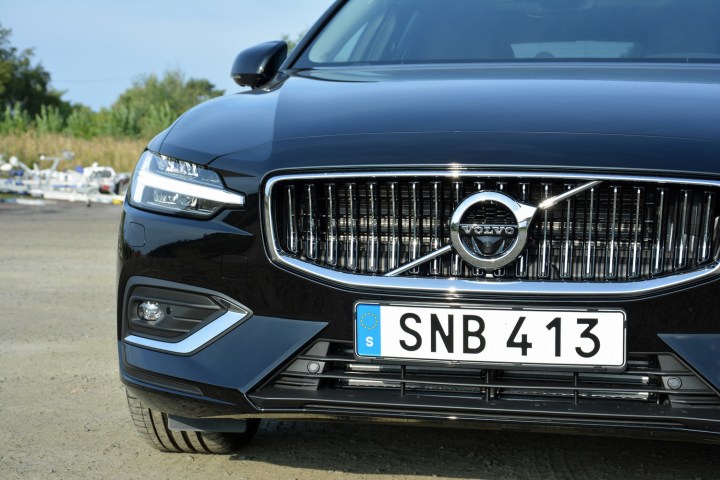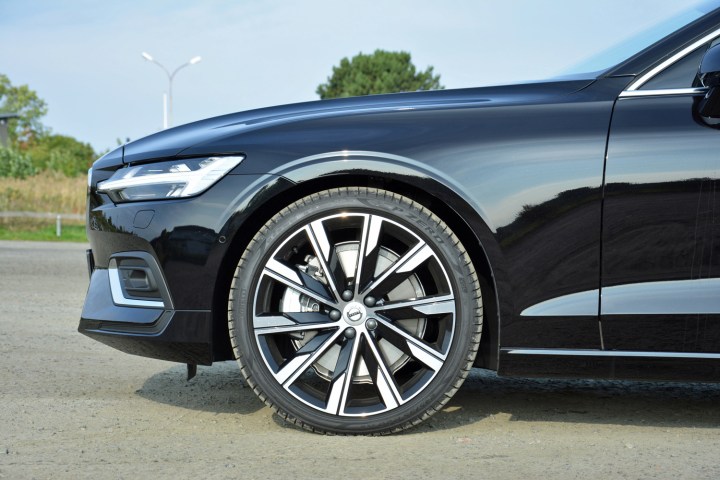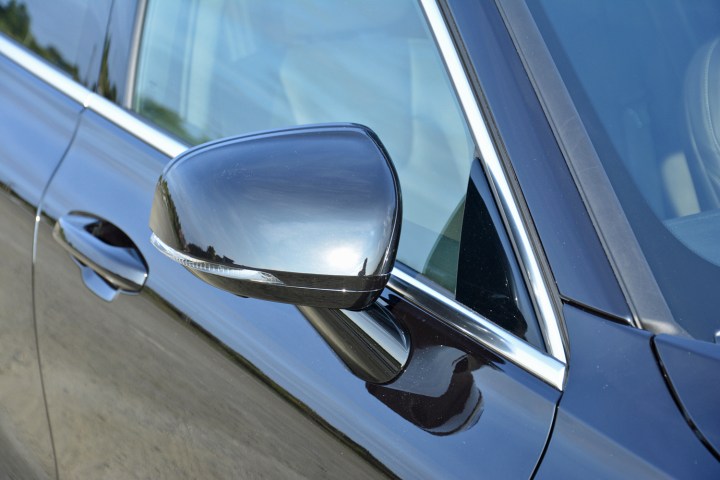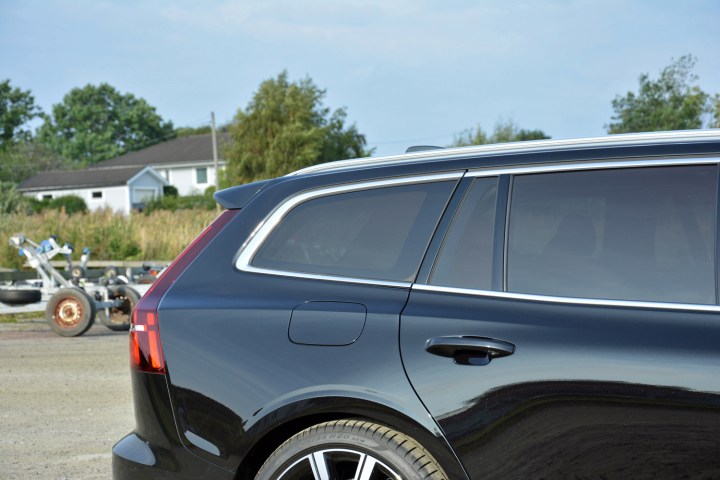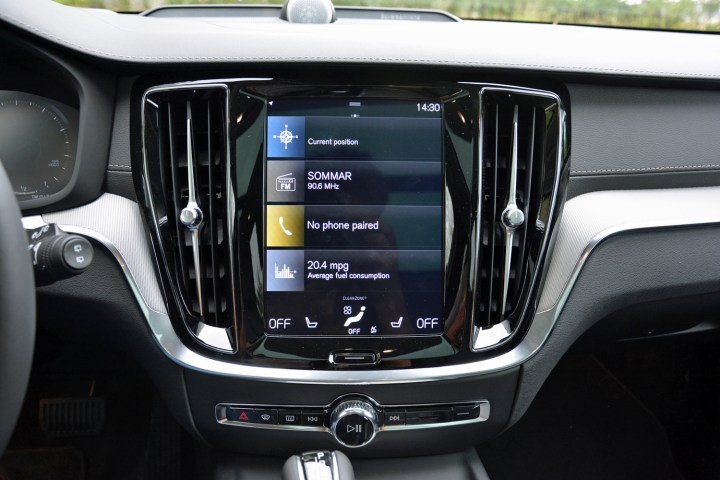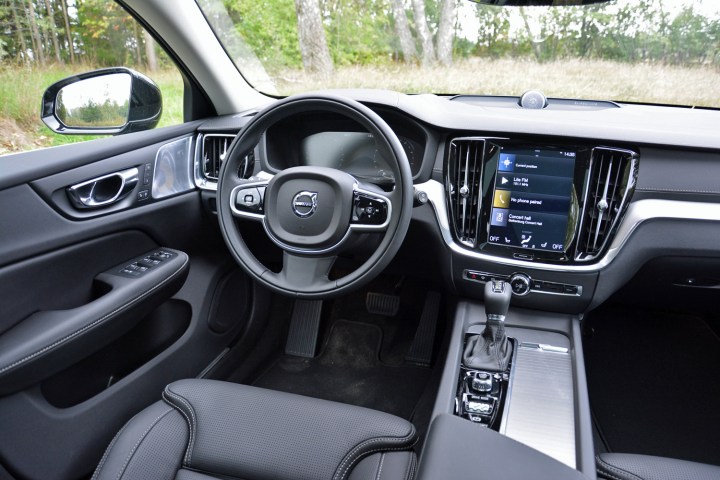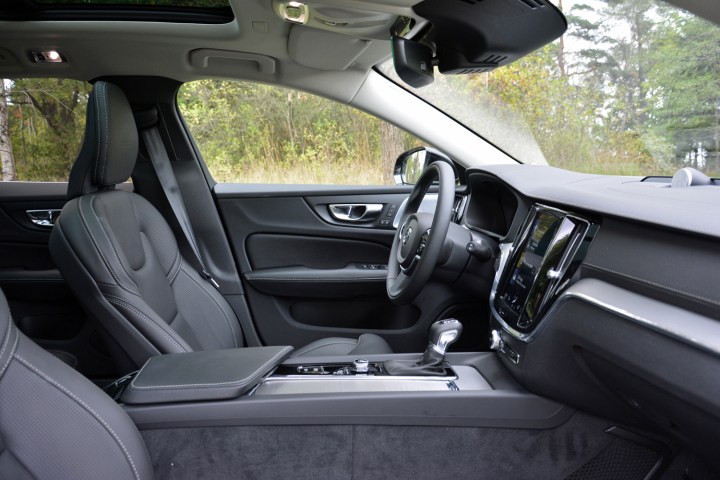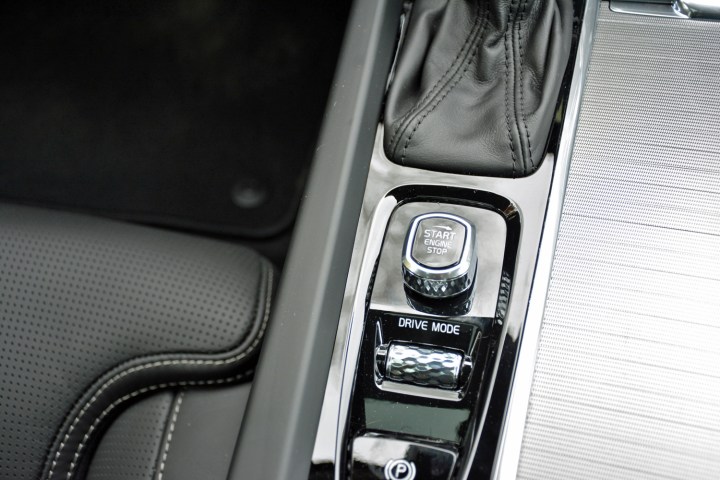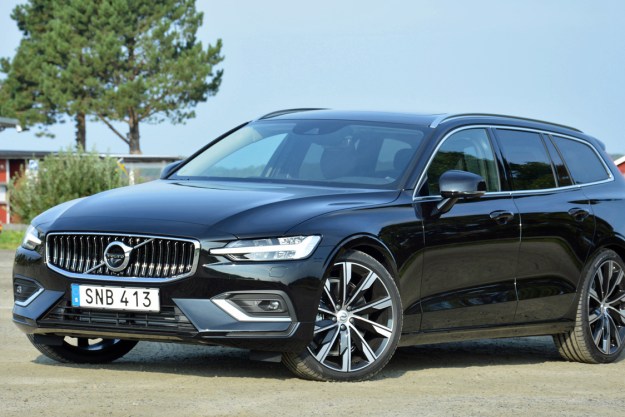
“The 2019 Volvo V60 makes a strong case for itself as an alternative to a crossover or an SUV.”
- Refined ride
- Elegant design
- User-friendly infotainment
- Spacious
- Clunky transmission
- Not as engaging as rivals
It’s easy to argue the station wagon is the automotive equivalent of the Sony Walkman.
It’s a relic from a bygone era that largely appeals to a small group of devotees fueled by a messianic zeal. And, in the same way that you’re more likely to use Spotify than to pull a Walkman out of your JanSport backpack, buyers asked to choose between a station wagon and a crossover will pick the taller model a majority of the time. That’s why the wagon segment is shrinking into oblivion while crossovers are conquering America one driveway at a time.
This trend isn’t set in stone, and Volvo is one of the notable exceptions to the rule. It figured out how to sell station wagons to Americans decades ago and it has retained this uncontested leadership through hell and high waters. While rivals like BMW and Mercedes-Benz are moving away from the wagon body style in the United States, Volvo is doubling-down on it. Digital Trends traveled to the firm’s home town of Gothenburg, Sweden, to try the brand-new 2019 V60.
V is Volvo-speak for wagon, while 60 indicates it’s a mid-range model positioned between the 40 series – represented solely by the XC40 in America – and the bigger 90-badged models. The V60 comes generously equipped with a nine-inch screen for the infotainment system, full smartphone integration, an eight-speaker sound system, a multi-function steering wheel, a panoramic roof, rain-sensing windshield wipers, a power-operated tailgate, dual-zone A/C, heated front seats, LED headlights, and 18-inch alloy wheels. Pricing information for the American market hasn’t been released yet.
Like the big kids
We had numerous conversations with Volvo executives, designers, and engineers when the firm was putting its model offensive on rails. One key point that stood out was the need to establish a high degree of standardization across the lineup to keep development costs in check. This worked in the V60’s favor because it receives the exact same Sensus infotainment system found in the bigger, costlier V90 positioned in the next segment up. It’s displayed on a portrait-oriented screen embedded in the center stack. The system replaces dozens of buttons, though Volvo retained a small cluster of them – including a true, honest-to-goodness volume knob – in the space right below the screen.
While Sensus isn’t the newest infotainment system on the lot anymore, it remains one of our favorites because it displays information in a clear, logical, and intuitive way. The home menu provides five basic options: Navigation, media, connectivity, sound settings, and climate settings. Alternatively, you can use swiping motions to access built-in applications (like weather, local search, and park and pay) or the numerous car functions (such as lane-keeping assist, park assist, and the start stop system). We like that nearly everything is where you expect to find it and it’s easy to create mental shortcuts to commonly-used features because the menus are shallow. Recent hardware updates make Sensus faster than before, too.
We had no trouble reading information on our test car’s digital instrument cluster, even with the bright, late-summer Scandinavian sun working overtime to dim it. It’s another piece of tech that has trickled down from bigger models. The V90 Cross Country we drove in 2017 used the same cluster. The screen gets the job done, and it cuts distractions by putting a map with turn-by-turn navigation directions right in the driver’s line of sight, but it isn’t as interactive or feature-rich as the Virtual Cockpit offered optionally on the Audi A4 Allroad.
If it ain’t broke…
The V60 embodies Volvo’s approach to design. It’s assertive and confident without venturing into the aggressive end of the spectrum. It’s also undeniably familiar; we wish Volvo had dialed in an additional degree of separation between the V60 and the V90. The front end is characterized by a wide grille with horizontal slats, a styling cue that channels the spirit of the P1800 sports car from the 1960s. It’s flanked by swept-back headlights with integrated T-shaped LED daytime running lights Volvo calls Thor’s Hammer.

In profile, it wears the typical long-roof proportions you expect to see on a station wagon. The D-pillar doesn’t have quite the same amount of rake as the V90’s, a concession made in the name of function-over-form design. L-shaped lights emphasize the rear end’s height and width while the roof-mounted spoiler makes sure the front end’s boldness flows to the back. We’d go on record calling the overall design sexy. It’s sharp, lean, and overall well executed. One thing is for sure: the V60 is a lot more interesting to look at than the Volvo your professor neighbor and his librarian wife drove in the 1990s.
Driving the V60 means loosening up. It’s riding with serenity as your co-pilot.
You may experience a moment of déjà vu after stepping inside. Here again, designers took a long, hard look at other models – including the aforementioned 90 models – before sharpening their pencils. In their defense, this degree of commonality was all but inevitable considering the number of parts the V60 shares with more expensive Volvo models. It’s not a fault by any means. We’ve praised Volvo’s other models in the past for their polished, human-centric interior made with quality materials and this one is no different. The seats are comfortable, visibility is excellent, and the passengers are surrounded by parts that look and feel upmarket. In this respect, Volvo has nothing to envy its German rivals.
Leave the second-row seats up and you’ve got 29.7 cubic feet of trunk space to fill. Fold the rear bench down and the V60 boasts 48.2 cubes. To add context, the XC60 offers 30.8 and 67.4 cubic feet, respectively. The Audi A4 Allroad initially trails the V60 with 24.2 cubic feet when four adults are traveling in the car but it leaps ahead with 58.5 cubes once the rear seats exit the equation.
Sit back and relax
We drove the V60 with an engine Volvo refers to as the T6. Don’t get the wrong idea: It’s not a V12 that has been cut in half and whose cylinders have been re-arranged into a T configuration. That would be cool but more than a little bit unpractical. T6 corresponds to a 2.0-liter four-cylinder that’s direct-injected, turbocharged, and supercharged to deliver 316 horsepower at 5,700 rpm and 295 pound-feet of torque between 2,200 and 5,400 rpm. It spins the four wheels through an eight-speed automatic transmission.
At launch, the roster of engines will also include an option called T5, a 2.0-liter four which loses the T6’s supercharger for turbo-only performance and sends its 250 hp output to the front wheels only. Volvo will add a 400-horsepower, gasoline-electric plug-in hybrid drivetrain called T8 later in the production run. There’s no T7, if you’re wondering.
Driving the V60 means loosening up. It’s riding with serenity as your co-pilot. Sure, Volvo’s drive mode selector gives you the option of making the suspension tighter and sharpening the throttle response but the V60 isn’t a sports car and it wasn’t designed as one. The steering is typical Volvo, meaning light and reasonably quick but without a ton of feedback, and the chassis engineers tuned the suspension with comfort in mind. It happily shows that it’s more dynamic than the bigger V90 but, if it’s engagement you want above all, we suggest looking at the A4 Allroad or the BMW 3 Series Sports Wagon.
Then there’s the wow-factor: The V60 stands out in a crowd in a way that the XC60 can’t.
But if you want a wagon that is cool, calm, and collected, this is it. The 316 hp engine delivers quick, linear acceleration that makes merging onto the freeway a breeze. It effortlessly cruises along for miles on end once it’s there, a trait it shares with all of its predecessors. The seats go easy on your back and heaps of sound-deadening material keep the noise down in the cabin, though the four-cylinder’s groan becomes markedly louder as it approaches the top end of its rev range.
When you come to a bend in the road, the V60 takes it in without an alarming amount of body lean. The adjustable suspension – steel, not air – delivers a controlled, Goldilocks-style ride that’s not too harsh and not too soft. In terms of everyday comfort and refinement, this is right where you want to be. The drivetrain’s finesse is only let down by the eight-speed automatic transmission, which is occasionally confused and clunky at low speeds, like when driving from stop sign to stop sign around town.

The passengers sit relatively low in the V60 but the large side windows give the driver a good view of what’s around the car. You’d have no excuse for leaving a paint print on the bottom part of the doors. The light steering helps the V60 tackle crowded urban areas by making it easy to maneuver in and out of tight spaces. It’s not a small car by any means of measurement but it feels nimbler than it looks.
Our time behind the wheel was too short to accurately measure real-world fuel economy. The Environmental Protection Agency (EPA) hasn’t released gas mileage figures for the V60 yet.
Safe and sound
Volvo may as well mean “safe” in Swedish.
The V60 comes standard with dual front, front side, and curtain airbags in addition to a knee airbag for the driver. It also boasts lane-keeping assist, oncoming lane mitigation, a whiplash protection system, and road sign information technology. We found the road sign information feature handy because it takes some of the guesswork out of driving on rural, unfamiliar roads where the speed limit isn’t indicated on a regular basis. It’s a safer option than following the locals with fingers crossed and hoping for the best.
Pilot Assist now does a much better job of tracing a straight line and following it.
Our test car came with Volvo’s semi-autonomous Pilot Assist technology. It combines adaptive cruise control and lane-keeping assist to take some of the burden out of driving in dense traffic. It’s not a hands- or eyes-off system, the driver needs to remain alert and focused on the road ahead at all times, but Pilot Assist got us through the epic traffic jam we encountered driving into Gothenburg with no fuss. In the past, we’ve criticized its tendency to ping-pong the car between lanes. Volvo has improved the technology over the past couple of years so it now does a much better job of tracing a straight line and following it.
Volvo hasn’t released warranty information for the V60 yet but it’s reasonable to assume that, like other members of the company’s lineup, it will come with four years or 50,000 miles of coverage.
The challengers
Not many car companies are willing to take the financial risk of selling a wagon to Americans. The Volvo V60’s main rival is the BMW 3 Series Sports Wagon, a model that places a greater emphasis on driving engagement than on comfort. Here’s the catch: BMW introduced a brand-new 3 Series sedan in October 2018 so it stands to reason the current-generation wagon isn’t long for this world. We’ll see its replacement in early 2019 but it’s too early to tell whether it will again make the trip across the pond. BMW may not be able to make a business case for another American-spec wagon.
The V60 can also be cross-shopped against the Audi A4 Allroad, though its rugged demeanor is a better match for the Cross Country variant of Volvo’s mid-range wagon. Well-equipped variants of the Euro-bred Buick Regal TourX and the perennially popular Subaru Outback are other options buyers that shouldn’t rule out without driving. Finally, the V60 inevitably faces internal competition from Volvo’s very own XC60 and S60 models.
How DT would configure this car
If we were spending our own money, we’d select the mid-range R-Design trim level for its blend of design and technology features. The list of standard equipment includes LED headlights, a panoramic roof, a power-operated hatch, Apple CarPlay and Android Auto compatibility, navigation, heated front seats, and 18-inch alloy wheels. We’d skip Park Assist Pilot but we’d pay extra for the upgraded Bowers & Wilkins sound system. In this configuration, our dream V60 would be ready for commuting or adventure.
Conclusion
The station wagon and the crossover are variations of the same theme. The former is a hatchback with a longer roof; the latter is a taller hatchback with, more often than not, plastic cladding over the wheel arches. The Volvo V60 rides lower than the XC60, it doesn’t provide the same commanding view of the road ahead, but what you give up in ground clearance you get back in car-like drivability.
Then there’s the wow-factor: The V60 stands out in a crowd in a way that the XC60 can’t, simply because there aren’t that many wagons meandering across the automotive landscape. While the Sony Walkman won’t get its hipness back anytime soon, we wouldn’t rule out a wagon revival over the coming years. And, judging by the time we spent in the Volvo V60, early adopters are in for a real treat.
Editors' Recommendations
- Watch your back, Tesla. Volvo’s EX30 just raised the bar on EV value
- 2024 Mercedes-AMG S63 E Performance first drive review: high-performance plug-in
- Hyundai Ioniq 6 first drive review: welcome to the future
- 2023 Kia Niro EV first drive review: Practical doesn’t have to bore you to tears
- 2022 Volkswagen ID. Buzz first drive review: The iconic hippie hauler goes electric

